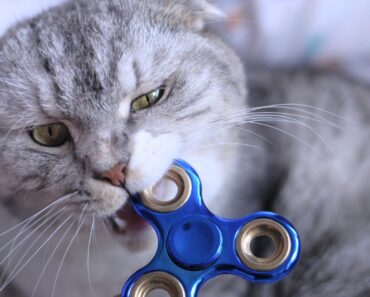
Mustachioed pets get used to the litter box pretty quickly, but to keep it clean, you have to constantly clean and disinfect it. For busy owners, this is a difficult task, so the litter box fills with unpleasant odors and “sand sculptures” made from the litter. In this case, it is best to teach the cat to relieve itself, as this has many advantages.
Can a cat be toilet trained?
Despite some difficulties in training, almost all cats with whiskers can be toilet trained. The owner does not need to be a professional trainer, as the whole process follows a standard algorithm and requires no special adjustments.
At what age to start
It is recommended to start potty training one or more cats after the age of 5-6 months. At this age, their musculoskeletal system is getting stronger, so they won’t be injured if they accidentally fall from a height. Six-month-olds also learn to balance well and are much easier to train than kittens.
If you’re already used to the litter box
The ability to use the litter box is not a disadvantage, but an advantage. It plays an important role in learning how to use the litter box. Your pet should therefore be used to going to the litter box before he is six months old.
If you have several pets, don’t try to take care of all of them and focus on one. In this case, the cat that does well will serve as an example to the others.
The learning curve doesn’t narrow until after the age of two or three. At this age, older pets are less likely to break their habits, so retraining will rarely have the desired effect.
What is the advantage of having a cat on the toilet?
Before we know how to toilet train a cat, we need to understand why you should do it. The main benefits of this type of potty training are:
- Space saving. In small apartments with separate bathrooms and toilets, the litter box “eats” a lot of space. This is especially problematic if you have multiple pets.
- No unpleasant and distinctive cat smell.
- Save money. No need to buy litter after potty training.
- Ease of care. Daily cleaning of feces and soaked litter is replaced by the periodic push of a button on the tank.
And don’t forget to show it off to your friends, because a well-trained pet is a point of pride.
How to toilet train a cat using a litter box
It is important to follow a certain sequence to train your cat to litter. There are 4 steps to follow to achieve your goal.
Move the litter box closer to the toilet
If your pet’s litter box is not in another room, you can skip this step. In other cases, the main task will be to familiarize her with unfamiliar sounds. Pets feel more vulnerable when they relieve themselves, and the noise inside the pipes, when flushing and turning on the faucet, can be very annoying.
However, it is important to remember that cats are very curious. Once they have access to a previously forbidden room, they do not fail to explore it and have no trouble getting used to its “special effects” by themselves.
Move the cat’s “potty” about a foot or two toward the toilet, then slowly reduce the distance over the next few days, moving in the right direction. Once you’ve reached the toilet, wait a few days to let the cat get used to the new location. If it doesn’t pass, feel free to move on to the next step.
Raising it to the right level
The second step is to get it used to the height. “The mustache must get used to going to the bathroom at the toilet rim. To do this, his litter box must be raised with suitable materials: cardboard, old magazines or newspapers. Every day, the structure should be raised 1 to 2 cm.
If the new height is too frightening, go back to the previous height, give your pet a break for a few days, then start again. Remember, the structure should be stable and not wobbly.
As you raise the litter tray, reduce the amount of litter so that eventually there is none left. This is necessary to get the tray used to handling without digging holes.
Put the litter box on the toilet
Once you’ve reached the right height, wait a few days for the cat to get used to going in this new place. Once that’s established, carefully move part of the litter box directly over the toilet. Take your time and move no more than ¼ of the litter box at a time.
After 3 to 4 days, the cat’s “potty” should settle completely in its new location. The support structure can then be removed.
Removing the Litter Box
Once you are sure the litter box is habituated, remove it and hide it in a place where it cannot be found, even by smell. A confused cat may fuss over its loss at first, but will eventually sit on the rim and relieve itself.
If he refuses to accept the new circumstances, return him to the litter box for a few days, then put him away again. Continue to do this until the cat is used to it.
Training time
The learning curve is very individual. The animals most likely to become accustomed to the new environment are those who have already shown an interest in the toilet and those who defecate in the toilet or bathroom. Another important factor is the habit of going directly to the litter box net. In this case, owners may be able to get the cat to go to the litter box in 5 to 7 days.
If your cat is shy and has a negative attitude toward any change, the learning process may take several months. If you encounter resistance, be patient and don’t force things, but let the cat learn at its own pace.
Auxiliary device: a special nozzle
The second and third steps can be modified slightly. If you find that the construction using locally available materials does not inspire confidence in your pet, get a special accessory. These can be found in pet supplies at any market place. Before buying, remember to consider the weight of your mustache. The heavier it is, the stronger the material should be.
Most products are plastic toilet seats consisting of four rings. It is attached under the rim of the toilet, and the actual habituation process is as follows:
- Familiarization. Pour some used litter from the cat’s “potty” into the product to attract the owner’s attention with a familiar smell.
- Replacement. The litter box is removed as soon as the cat starts to poop here and there.
- Gradual removal of rings. Reusable models have removable rings, which is convenient if you have multiple pets. More economical versions involve cutting a progressively larger hole along the marked outline yourself.
- Remove the nozzle assembly. As you learn, the “mustachian” remembers not to stand in the middle and to keep his paws strictly on the edge. As the hole grows, he learns not to dig the filling anymore.
The main advantage of this accessory is that there is no abrupt transition between the litter box and the toilet. Your pet will have much more time to get used to its new environment: the hole under its feet and the splash of water when it throws its excrement in.
Advice to owners
- Despite the overall effectiveness of the technique discussed, there are other contraindications to this technique other than small age. It is not suitable for the following animals:
- Too fearful. In the wild, cats bury their feces to hide their presence from potential enemies. If your pet doesn’t feel safe, it will resist the new environment with all its might.
- Sedentary and fat. The more overweight your body is, the less agile its owner is. The same goes for slippers, who can easily get hurt if their feet don’t fit on the rim.
- Sick, frail or elderly. Disturbing these animals with changes is unwise and downright dangerous.
- Pregnant and nursing pets. The idea is the same as above, but with one caveat. A new mother can be started soon after her kittens are weaned.
The speed at which a new kitten learns a new technique depends not only on the initial conditions, but also on the owner’s own actions.
Throughout the training, try to follow these guidelines:
- Do not close the toilet door or put the toilet lid down. If you don’t like to see the toilet ajar, cut a small hole in the door for the whip to enter.
- Encourage correct actions with praise, hugs and rewards.
- Be patient and consistent. If you don’t have enough free time or inclination for daily training, continue to use the regular set.
- Be sure to back up a few steps if you have a negative reaction to the new innovation. Otherwise, a frustrated pet could be led to urinate in the wrong place.
- Avoid punishment. Don’t scold or punish your pet if it goes in the wrong place. Such a reaction is not helpful and will only add to his stress.
- Do not rush to remove the rings from the special nozzle. The recommended time to get used to each one is 5 to 6 days.
Remember that once the habit is established, the toilet door and lid will need to remain open at all times. Be sure to explain this to all family members and remember to keep an eye on the environment when guests arrive who may accidentally forget the instructions you have given.
Conclusion
Changes are very stressful for your cat. That’s why you should try not to push him too hard and always praise him, even for seemingly minor successes. Your support at every stage of domestication will reduce anxiety and greatly increase the chances of success.






